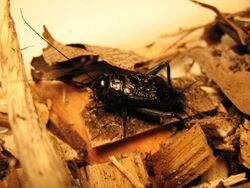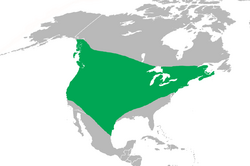Biology:Gryllus pennsylvanicus
| Gryllus pennsylvanicus | |
|---|---|

| |
| A male Gryllus pennsylvanicus | |
| Scientific classification Error creating thumbnail: Unable to save thumbnail to destination
| |
| Domain: | Eukaryota |
| Kingdom: | Animalia |
| Phylum: | Arthropoda |
| Class: | Insecta |
| Order: | Orthoptera |
| Suborder: | Ensifera |
| Family: | Gryllidae |
| Genus: | Gryllus |
| Species: | G. pennsylvanicus
|
| Binomial name | |
| Gryllus pennsylvanicus Burmeister, 1838 [1]
| |

| |
| Synonyms [2] | |
| |
Gryllus pennsylvanicus is known as the fall field cricket. G. pennsylvanicus is common in southern Ontario, is widespread across much of North America[3][4] and can be found even into parts of northern Mexico. It tends to be absent in most of the southwestern United States including southern California . Within its geographic range this field cricket will burrow into soil in fields and forest edges.[5] Individuals inhabit grassy disturbed areas [4][6] and are often found around areas of human habitation.[7]
Identification
Adults reach 15–25 millimetres (0.6–1.0 in) and coloration ranges from dark black to dark brown, although some specimens show a slight reddish tint.[8] The black antennae tend to be longer than the body span of the species. The cerci are longer than the head and prothorax, and the wings do not extend past the cerci.[9]
Life cycle
During the breeding season, the number of adult female G. pennsylvanicus captured in pitfall traps peaks approximately two weeks after the peak in the number of adult males captured,[10] which seems to indicate protandry. Breeding in some areas also coincides with the seed rain from certain agricultural weeds,[11] possibly providing females with food resources to increase their fecundity. Males call from the mouths of burrows or cracks in the ground into which they escape when scared. Calling males are separated from each other by approximately 7.7 to 10.3 m in the field,[12] likely making it costly for females to sample large numbers of potential mates. Male G. pennsylvanicus calling song consists of short chirps – roughly two to three per second – each consisting of three to five pulses (each a single closure of the male forewings or tegmina).[13][14] File:Field cricket Gryllus pennsylvanicus.ogg Like most other gryllines, females are attracted to male calling song [15][16][17] and are attracted to higher calling effort at least when population density is low.[18] In an elegant series of field experiments, Zuk [19] showed that female G. pennsylvanicus were more attracted to calling song produced by older males than that of younger males. Males found paired with females in the field were also older than unpaired calling males nearby.[20] However, in the earlier experiment higher calling effort explained a small, but statistically significant proportion of the variance in female attraction,[19] raising the possibility that the apparent preference of females for the songs of older males might be due to differences in calling effort between older and younger males.
Adults are mostly active during night when the males sing to attract females.[15] Females will then lay their eggs by injecting their ovipositor into soil.[citation needed] A single female will lay around 50 eggs at a time and can lay well over 400 eggs in her life span.[citation needed] Eggs laid in the late summer and fall seasons will overwinter and hatch the following spring.[13][21] There is one generation per year.[13] Sometimes as winter approaches adults will find their way into houses where they will try to overwinter.[citation needed]
Life history evolution
Because the only reliable method of distinguishing G. pennsylvanicus and G. veletis is based on the timing of their life history,[13] Alexander and Bigelow [21] proposed that G. veletis and G. pennsylvanicus were sister species and had diverged through a process of allochronic speciation, whereby a temporal separation between the breeding seasons of the two incipient species restricts gene flow.[21] However, G. veletis and G. pennsylvanicus are not sister taxa; instead, G. pennsylvanicus form a well-supported clade with G. ovisopis and G. firmus,[22][23] the latter of which forms an extensive hybrid zone with G. pennsylvanicus in the eastern United States.[24] Currently, a major molecular phylogenetic revision of North American Gryllinae is underway (D. Gray, pers. comm.) that will include the approximately 20 [4] western species as well as eastern species left out of earlier phylogenies (e.g. G. vernalis). This greatly anticipated work will undoubtedly provide ample diversity fodder for research into the evolution of life histories.
Diet

G. pennsylvanicus is an omnivorous [25] organism and has been shown to be a significant predator of both seeds [10][11][26] and invertebrates.[27][28][29] The broad diet of G. pennsylvanicus, coupled with seasonal variation in the availability of different types of prey (plant or animal) could exert substantial diversifying selection on cricket life histories (i.e. the genotypes that are optimal in high seed abundance years are likely different from those that are most fit in years of high invertebrate prey – genotype by environment interactions [30]).
Recorded food plants of G. pennsylvanicus include smooth crabgrass (Digitaria ischaemum), lamb's quarters (Chenopodium album), English plantain (Plantago lanceolata), switchgrass (Panicum virgatum), common ragweed (Ambrosia artemisiifolia) and chicory (Cichorium intybus). Even though they are a sizable cricket for North America they are preyed upon by everything from hawks to hornets.
Gallery
References
- ↑ "Gryllus pennsylvanicus Burmeister, 1838". Integrated Taxonomic Information System. https://www.itis.gov/servlet/SingleRpt/SingleRpt?search_topic=TSN&search_value=658225.
- ↑ "Gryllus pennsylvanicus (Pennsylvania Field Cricket)". http://zipcodezoo.com/Animals/G/Gryllus_pennsylvanicus/. Retrieved February 3, 2009.
- ↑ Alexander, R. D. 1968. Life cycle origins, speciation, and related phenomena in crickets. Q. Rev. Biol. 43, 1-41.
- ↑ 4.0 4.1 4.2 Capinera, J. L., Scott, R. D., and Walker, T. J. 2004. Field Guide to Grasshoppers, Katydids, and Crickets of the United States. Ithaca, NY: Cornell University Press.
- ↑ "Species Gryllus pennsylvanicus - Fall Field Cricket - BugGuide.Net". http://bugguide.net/node/view/8007. Retrieved February 3, 2009.
- ↑ Tennis, P. 1983. Survivorship, spatial pattern, and habitat structure of field crickets (Orthoptera: Gryllidae) in two old fields. Environmental Entomology 12, 110-116.
- ↑ Alexander, R. D., and Meral, G. H. 1967. Seasonal and daily chirping cycles in the northern spring and fall field crickets, Gryllus veletis and G. pennsylvanicus. Ohio J. Sci. 67, 200-209.
- ↑ Evans, Arthur V. (2007). "Grasshoppers, Cricketys, and Katydids: Order Orthoptera". Field Guide to Insects and Spiders of North America. Sterling Publishing Co., Inc. p. 100. ISBN 978-1-4027-4153-1.
- ↑ Knopf, Milne & Milne (2005). "Grasshoppers and Crickets". National Audubon Society Field Guide to North American Insects & Spiders (23rd ed.). Alfred A. Knopf, Inc. p. 439. ISBN 0-394-50763-0. https://archive.org/details/nationalaudubons00miln/page/439.
- ↑ 10.0 10.1 Carmona, D. M., Menalled, F. D., and Landis, D. A. 1999. Gryllus pennsylvanicus (Orthoptera: Gryllidae): laboratory weed seed predation and within field activity-density. J. Econ. Entomol. 92, 825-829.
- ↑ 11.0 11.1 O'Rourke, M. E., Heggenstaller, A. H., Liebman, M., and Rice, M. E. 2006. Post-dispersal weed seed predation by invertebrates in conventional and low-external-input crop rotation systems. Agr. Ecosyst. Environ. 116, 280-288.
- ↑ French, B. W., McGowan, E. J., and Backus, V. L. 1986. Spatial distribution of calling field crickets, Gryllus pennsylvanicus (Orthoptera: Gryllidae). Fla. Entomol. 69, 255-257.
- ↑ 13.0 13.1 13.2 13.3 Alexander, R. D. 1957. The taxonomy of the field crickets of the eastern United States (Orthoptera: Gryllidae: Acheta). Ann. Entomol. Soc. Am. 50, 584-602.
- ↑ Doherty, J. A., and Storz, M. M. 1992. Calling song and selective phonotaxis in the field crickets, Gryllus firmus and G. pennsylvanicus (Orthoptera: Gryllidae). J. Insect Behav. 5, 555-569.
- ↑ 15.0 15.1 Alexander, R. D. 1961. Aggressiveness, territoriality, and sexual behavior in field crickets (Orthoptera: Gryllidae). Behaviour 17, 130-223.
- ↑ Loher, W. and Dambach, M. 1989. Reproductive behavior. In Cricket Behavior and Neurobiology (ed. Huber, F., Moore, T. E., and Loher, W.), pp. 43-82. Ithaca, NY: Cornell University Press.
- ↑ Jeffery, J., Navia, B., Atkins, G., and Stout, J. 2005. Selective processing of calling songs by auditory interneurons in the female cricket, Gryllus pennsylvanicus: possible roles in behavior. J. Exp. Zool. Comp. Exp. Biol. 303A, 377-392.
- ↑ French, B. W., and Cade, W. H. 1987. The timing of calling, movement, and mating in the field crickets Gryllus veletis, G. pennsylvanicus, and G. integer. Behav. Ecol. Sociobiol. 21, 157-162.
- ↑ 19.0 19.1 Zuk, M. 1987. Variability in attractiveness of male field crickets (Orthoptera: Gryllidae) to females. Anim. Behav. 35, 1240-1248.
- ↑ Zuk, M. 1988. Parasite load, body size, and age of wild-caught male field crickets (Orthoptera, Gryllidae): effects on sexual selection. Evolution 42, 969-976.
- ↑ 21.0 21.1 21.2 Alexander, R. D., and Bigelow, R. S. 1960. Allochronic speciation in field crickets, and a new species, Acheta veletis. Evolution 14, 334-346.
- ↑ Harrison, R. G., and Bogdanowicz, S. M. 1995. Mitochondrial DNA phylogeny of North American field crickets: perspectives on the evolution of life cycles, songs, and habitat associations. J. Evol. Biol. 8, 209-232.
- ↑ Huang, Y., Orti, G., Sutherlin, M., Duhachek, A., and Zera, A. 2000. Phylogenetic relationships of North American field crickets inferred from mitochondrial DNA data. Mol. Phylogenet. Evol. 17, 48-57.
- ↑ Harrison, R. G., and Arnold, J. 1982. A narrow hybrid zone between closely related cricket species. Evolution 36, 535-552.
- ↑ Criddle, N. 1925. Field crickets in Manitoba. Can. Entomol. 57, 79-84.
- ↑ Brust, E. G., and House, G. J. 1988. Weed seed destruction by arthropods and rodents in low-input soybean agro-ecosystems. Am. J. Alt. Agric. 3, 19-24.
- ↑ Monteith, L. G. 1971. Crickets as predators of the apple maggot, Rhagoletis pomonella (Diptera: Tephritidae). Can. Entomol. 103, 52-58.
- ↑ Bechinski, E. J., Bechinski, J. F., and Pedigo, L. P. 1983. Survivorship of experimental green cloverworm (Lepidoptera: Noctuidae) pupal cohorts in soybeans. Environ. Entomol. 12, 662-668.
- ↑ Burgess, L. and Hinks, C. F. 1987. Predation on adults of the crucifer flea beetle, Phyllotreta cruciferae (Goeze), by the northern fall field cricket, Gryllus pennsylvanicus Burmeister (Orthoptera: Gryllidae). Can. Entomol. 119, 495-496.
- ↑ Reznick, D., Nunney, L., and Tessier, A. 2000. Big houses, big cars, superfleas and the costs of reproduction. Trends Ecol. Evol. 15, 421-425.
Wikidata ☰ Q5612416 entry
 |





